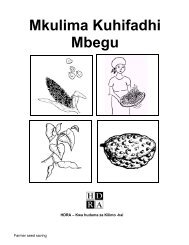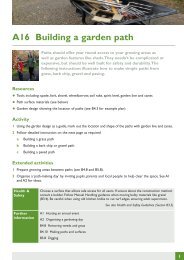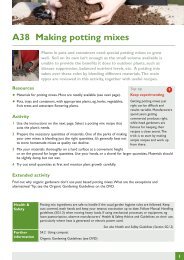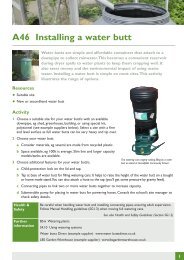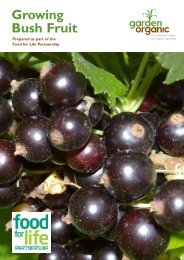Download PDF - Garden Organic
Download PDF - Garden Organic
Download PDF - Garden Organic
Create successful ePaper yourself
Turn your PDF publications into a flip-book with our unique Google optimized e-Paper software.
http://www.gardenorganic.org.uk/organicweeds<br />
Secondary tillage<br />
Secondary tillage is used to prepare seedbeds and leave a level surface for drilling or<br />
planting. Typically it involves disking or harrowing to a depth of 10 cm. The cutting<br />
and mixing action of the disk harrow depends on the diameter, weight and concavity<br />
of the blades (Bowman, 1997). Rotovators and power harrows are also used and are<br />
able to prepare seedbeds even when ploughing has not been carried out. Implements<br />
are available that can combine shallow seedbed preparations with some deeper<br />
cultivations in a single pass (Lampkin, 1998). Others can loosen the soil below the<br />
surface while leaving the preceding crop debris on the soil surface.<br />
The timing of seedbed preparation affects weed populations considerably and is an<br />
opportunity to reduce weed numbers that emerge in the growing crop. One traditional<br />
method of weed control is the stale or false seedbed technique. A novel method of<br />
reducing seedling emergence is to carry out the seedbed preparations in the dark to<br />
avoid stimulating weed seed germination.<br />
Timing<br />
It is well known that sowing autumn cereals as late as possible allows blackgrass (A.<br />
myosuroides) to germinate and be controlled before the cereal crop is established.<br />
Like blackgrass, many other weed species emerge only at particular times of year.<br />
Delaying drilling until mid-October may reduce disease problems as well as weeds<br />
but germination and growth of the crops can be slow making them vulnerable to slug<br />
attack (Leake, 1996). In spring-sown cereals, sowing date affects the composition of<br />
the weed flora (Milberg et al., 2001).<br />
Stale seedbed<br />
A stale or false seedbed, may be defined as a seedbed prepared several days, weeks or<br />
even months before planting or transplanting a crop (Johnson & Mullinix, 1995). The<br />
technique is recognised as a strategy suitable for organic farming and has been widely<br />
used for many years. It is based on the principle of flushing out germinable weed<br />
seeds prior to the planting of the crop, depleting the seedbank in the surface layer of<br />
soil and reducing subsequent weed seedling emergence. It can be an effective<br />
method of decreasing the density of annual weeds, as has been demonstrated in many<br />
studies including weed control in maize production systems (Leblanc & Cloutier,<br />
1996). The false seedbed technique involves a second shallow cultivation to kill the<br />
weeds after they emerge. The second cultivation often creates the true seedbed. The<br />
stale seedbed technique involves killing the weeds by methods such as flame weeding<br />
that do not disturb the soil surface. Punch planting makes use of the stale seedbed<br />
technique but minimises soil disturbance further by dropping the seed into holes made<br />
by a dibber (Rasmussen, 2003). Delaying sowing extends the stale seedbed effect.<br />
When soil temperatures are not limiting, the most important factor determining the<br />
timing of a flush of weed emergence is adequate soil moisture (Roberts & Potter,<br />
1980). Consequently, in dry years the stale seedbed method does not serve as a good<br />
method of weed control without the intervention of irrigation. The dependence of the<br />
strategy on soil moisture availability is clearly demonstrated by Bond & Baker<br />
(1990). When conditions were moist, 50% of the weed seedlings (expressed as a<br />
October 2007 4




